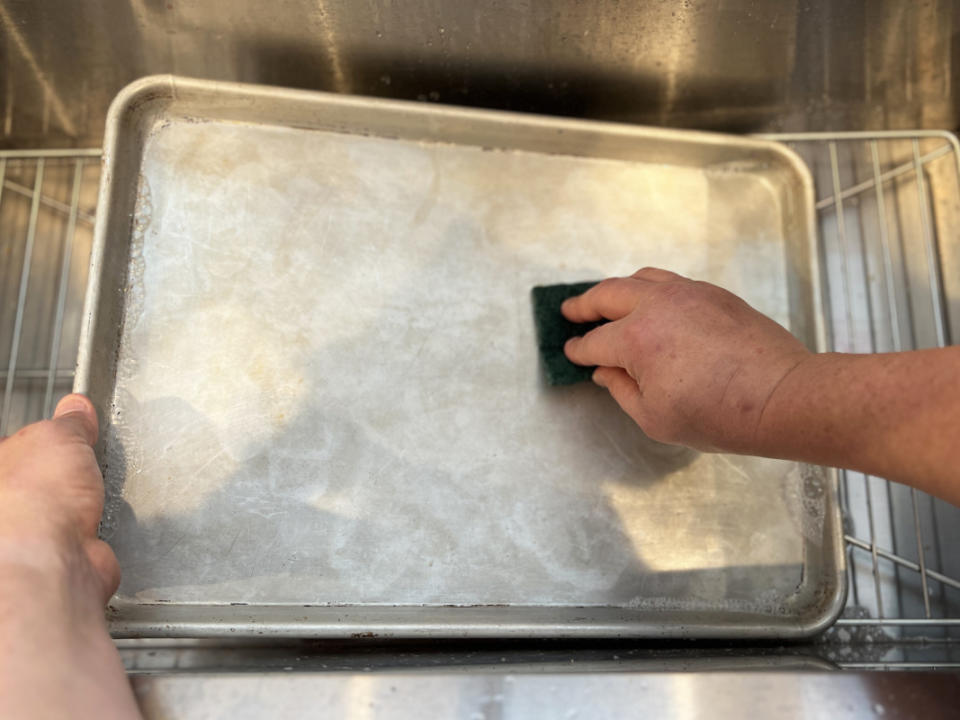How to Clean Baking Sheets
Baking sheets get a great workout throughout the year, and sometimes it shows. Learn how to keep your cooking sheet pans free of burned-on grime and residue build-up. P.S. We know, we know. Use the silicone baking mat... but sometimes it just isn't the same. #youknow
Causes of Dirty Baking Sheets
Baked cookies and sheet pan dinners, so good. Baked-on residue, an absolute buzzkill. The stuff that sticks to your cooking sheets is primarily composed of fats, oils, sugars, and food particles from the items you baked. When exposed to heat in the oven, these substances undergo chemical reactions, forming a sticky and sometimes burnt-on layer. If you don't keep up with a dedicated cleaning routine, it becomes harder and harder to clean the sheet.
Related: Do NOT Put These Items Down Your Kitchen Drain
How to Clean Baked-On Residue
Cleaning tough stains off your favorite baking sheets can be done effectively with a few simple steps.
Allow the sheet pan to cool completely before attempting to clean it.
Scrape off excess residue. Use a spatula or a flat-edged tool to remove loose bits.
Soak it in warm soapy water. Fill the sink or a large basin with warm water and add a few drops of liquid dish soap. Place it in the water to soak for 15-20 minutes.
Scrub away. Aluminum baking sheets can handle your elbow grease, so scrub away at the toughest stains; however, avoid using steel wool or non-scratch scouring pads as they can damage the surface of non-stick baking sheets.
Tackle tough residue. These cleaning mixtures make it easier to battle burned-on stains and baked-on gunk.
Baking soda/hydrogen peroxide paste. Make a baking soda paste by mixing the powder with hydrogen peroxide. Apply the paste to the problem areas and let it sit for 15-20 minutes. Then, scrub with a sponge or brush.
Cream of tartar. Sprinkle cream of tartar on the surface of the baking sheet, then top with enough white vinegar to coat the entire sheet. It'll need to sit, undisturbed, for several hours. Best to leave it overnight, and then scrub the pan in the morning. Only cleaning one tough spot? Make a vinegar + cream of tartar paste and allow it to sit concentrated on the burnt-on residue.
Dryer sheet trick. Place a dryer sheet in the bottom of the pan, along with a small amount of liquid dish soap. Add boiling water to cover the bottom of the baking sheet and then let the solution sit for 30-60 minutes. The dryer sheet helps break through grease and stubborn stains.
Vinegar solution. Mix equal parts white vinegar and hot water. Apply this mixture to the baking sheet and let it sit for 15-20 minutes before scrubbing.
Lemon and salt. Cut a lemon in half and sprinkle salt on the cut side. Use the lemon as a scrubber, rubbing it over the baking sheet. The acidity of the lemon and the abrasiveness of the salt can help in cleaning.
Rinse and dry. Once you've scrubbed away the residue, rinse the baking sheet thoroughly with warm water. Dry the sheet with a clean towel. Ensure that there's no leftover residue before storing the sheet pan. If necessary, repeat the cleaning process.

Emily Fazio
How to Keep Sheet Pans Looking Their Best
For an easier cleanup in the future, line your cookie sheet with a silicone mat.
Line your pans with parchment paper or aluminum foil before each use.
Be careful with nonstick coatings. They're more susceptible to scratches if you use a heavy-duty or abrasive scrubbing tool. Once it's scratched, it can develop rusty spots.
Remember that regular cleaning and avoiding harsh cleaning agents or tools will help preserve the quality and appearance of your baking sheets.
Related: How to Maintain Your Kitchen Sink Before Hosting Guests
